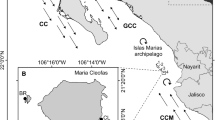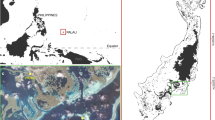Abstract
Reproduction and recruitment in high-latitude coral populations in Japan have been little studied. A comprehensive study of the reproduction and early life history was conducted on nine common scleractinian coral species in Amakusa, southwestern Japan (32°N) from 2001 to 2003 including; (1) fecundity (the proportion of colonies with mature eggs), (2) timing and synchrony of spawning, (3) initial larval settlement pattern, (4) recruitment, (5) post-settlement mortality. The fecundity was high (76.7–100%) in six of seven species examined in 2002 and 2003. Annual spawning of the seven species occurred from mid July to August in 2001–2003, when seawater temperature was at the annual maximum. Spawning was highly synchronised among conspecific colonies and species in 2002 and 2003, with five species spawning five to nine nights after the full moon and another two spawning around the new moon. Temporal patterns of larval settlement of three spawning species during the first 10 days after spawning were similar to those of other spawning species from low latitudes. The number of scleractinian recruits on settlement plates, deployed from July to October (the major recruitment period at the study site), was low (2 recruits/m2) for the three consecutive years. Post-settlement mortality of 1–1.5 month old spat of five species ranged between 88 and 100% over 3–10 months in the field, similar to the values reported for both high and low latitude species (>94–99%). Among the key stages examined, the low recruitment rate may be the most important step in limiting successful reproduction and recruitment of these high-latitude scleractinian populations. The low recruitment rate may be attributable to (1) the reduced influx of larval supply from other coral populations, which are smaller and more isolated at high-latitudes and (2) the longer precompetent larval phase of broadcast-spawning corals which results in an increased chance of larvae being dispersed away from parent populations.






Similar content being viewed by others
References
Babcock RC (1984) Reproduction and distribution of two species of Goniastrea (Scleractinia) from the Great Barrier Reef Province. Coral Reefs 2:187–195
Babcock RC (1985) Growth and mortality in juvenile corals (Goniastrea, Platygyra and Acropora): the first year. In: Proceedings of the 5th international coral reef congress, Tahiti, vol 4, pp 355–360
Babcock RC (1991) Comparative demography of three species of scleractinian corals using age- and size-dependent classifications. Ecol Monogr 61:225–244
Babcock RC, Heyward AJ (1986) Larval development of certain gamete-spawning scleractinian corals. Coral Reefs 5:111–116
Babcock R, Mundy C (1996) Coral recruitment: consequences of settlement choice for early growth and survivorship in two scleractinians. J Exp Mar Biol Ecol 206:179–201
Babcock RC, Willis BL, Simpson CJ (1994) Mass spawning of corals on a high latitude coral reef. Coral Reefs 13:161–169
Babcock RC, Baird AH, Piromvaragorn S, Thomson DP, Willis BL (2003) Identification of scleractinian coral recruits from Indo-Pacific reefs. Zool Stud 42:211–226
Baird AH (2001) The ecology of coral larvae: settlement patterns, habitat selection and the length of the larval phase. Phd Thesis, James Cook University
Baird AH, Babcock RC (2000) Morphological differences among three species of newly settled pocilloporid coral recruits. Coral Reefs 19:179–183
Baird AH, Marshall PA, Wolstenholme J (2000) Latitudinal variation in the reproduction of Acropora in the Coral Sea. In: Proceedings of the 9th international coral reef sympsium, Bali, vol 1, pp 385–389
Fairfull SJL, Harriott VJ (1999) Succession, space and coral recruitment in a subtropical fouling community. Mar Freshw Res 50:235–242
Glassom D, Zakai D, Chadwick-Furman NE (2004) Coral recruitment: a spatio-temporal analysis along the coastline of Eilat, northern Red Sea. Mar Biol 144:641–651
Goffredo S, Arnone S, Zaccanti F (2002) Sexual reproduction in the Mediterranean solitary coral Balanophyllia europaea (Scleractinia, Dendrophylliidae). Mar Ecol Prog Ser 229:83–94
Hall VR, Hughes TP (1996) Reproductive strategies of modular organisms: comparative studies of reef-building corals. Ecology 77:950–963
Harii S, Omori M, Yamakawa H, Koike Y (2001) Sexual reproduction and larval settlement of the zooxanthellate coral Alveopora japonica Eguchi at high latitudes. Coral Reefs 20:19–23
Harriott VJ (1992) Recruitment patterns of scleractinian corals in an isolated sub-tropical reef system. Coral Reefs 11:215–219
Harriott VJ (1999) Coral growth in subtropical eastern Australia. Coral Reefs 18:281–291
Harriott VJ, Banks SA (1995) Recruitment of scleractinian corals in the Solitary Islands Marine Reserve, a high-latitude coral-dominated community in Eastern Australia. Mar Ecol Prog Ser 123:155–161
Harriott VJ, Banks SA (2002) Latitudinal variation in coral communities in eastern Australia: a qualitative biophysical model of factors regulating coral reefs. Coral Reefs 21:83–94
Harriott VJ, Simpson CJ (1997) Coral recruitment in Western Australia. In: Proceedings of the 8th international coral reef symposium, Panama, vol 2, pp 1191–1196
Harrison PL, Wallace CC (1990) Reproduction, dispersal and recruitment of scleractinian corals. In: Dubinsky Z (ed) Ecosystems of the world, vol 25, coral reef ecosystems. Elsevier, Amsterdam, pp 133–207
Harvell CD, Grosberg RK (1988) The timing of sexual maturity in clonal animals. Ecology 69:1855–1864
Heyward A, Yamazato K, Yeemin T, Minei M (1987) Sexual reproduction of corals in Okinawa. Galaxea 6:331–343
Hughes TP, Baird AH, Dinsdale EA, Moltschaniwskyj NA, Pratchett MS, Tanner JE, Willis BL (2000) Supply-side ecology works both ways: the link between benthic adults, fecundity, and larval recruits. Ecology 81:2241–2249
Hughes TP, Baird AH, Dinsdale EA, Harriott VJ, Moltschaniwskyj NA, Pratchett MS, Tanner JE, Willis BL (2002) Detecting regional variation using meta-analysis and large-scale sampling: latitudinal patterns in recruitment. Ecology 83:436–451
Kapela W, Lasker HR (1999) Size-dependent reproduction in the Caribbean gorgonian Pseudoplexaura porosa. Mar Biol 135:107–114
Kleypas JA, McManus JW, Menez LAB (1999) Environmental limits to coral reef development: where do we draw the line? Am Zool 39:146–159
Miller K, Mundy C (2003) Rapid settlement in broadcast spawning corals: implications for larval dispersal. Coral Reefs 22:99–106
Nishihira M, Veron JEN (1995) Hermatypic corals of Japan (in Japanese). Kaiyusha Publishers, Tokyo
Nozawa Y, Harrison PL (2002) Larval settlement patterns, dispersal potential, and the effect of temperature on settlement of larvae of the reef coral, Platygyra daedalea, from the Great Barrier Reef. In: Proceedings of the 9th international coral reef symposium, Bali, vol 1, pp 409–415
Nozawa Y, Harrison PL (2005) Temporal settlement patterns of larvae of the broadcast spawning reef coral Favites chinensis and the broadcast spawning and brooding reef coral Goniastrea aspera from Okinawa, Japan. Coral Reefs 24:274–282
Sakai K (1997) Gametogenesis, spawning, and planula brooding by the reef coral Goniastrea aspera (Scleractinia) in Okinawa, Japan. Mar Ecol Prog Ser 151:67–72
Schwarz JA, Krupp DA, Weis VM (1999) Late larval development and onset of symbiosis in the scleractinian coral Fungia scutaria. Biol Bull 196:70–79
Shlesinger Y, Loya Y (1985) Coral community reproductive patterns: Red Sea versus the Great Barrier Reef. Science 228:1333–1335
Shlesinger Y, Loya Y (1991) Larval development and survivorship in the corals Favia favus and Platygyra lamellina. Hydrobiologia 216/217:101–108
Shlesinger Y, Goulet TL, Loya Y (1998) Reproductive patterns of scleractinian corals in the northern Red Sea. Mar Biol 132:691–701
Smith SR (1992) Patterns of coral recruitment and post-settlement mortality on Bermuda’s reefs: comparisons to Caribbean and Pacific reefs. Am Zool 32:663–673
Stehli FG, Wells JW (1971) Diversity and age patterns in hermatypic corals. Syst Zool 20:115–126
Thamrin (2001) Reproductive biology of a scleractinian coral Alveopora japonica Eguchi in Amakusa, South-western Japan. PhD dissertation, Kyushu University
Thamrin, Nojima S, Tokeshi M (2001) Experimental analysis of planula release in a scleractinian coral Alveopora japonica. Galaxea. JCRS 3:25–30
Tioho H, Tokeshi M, Nojima S (2001) Experimental analysis of recruitment in a scleractinian coral at high latitude. Mar Ecol Prog Ser 213:79–86
van Woesik R (1995) Coral communities at high latitude are not pseudopopulations: evidence of spawning at 32°N, Japan. Coral Reefs 14:119–120
Veron JEN (1974) Southern geographic limits to the distribution of Great Barrier Reef hermatypic corals. In: Proceedings of the 2nd international coral reef symposium, vol 2, pp 465–473
Veron JEN (1992) Hermatypic corals of Japan. Australian Inst Mar Sci Monogr Ser 9, Townsville
Veron JEN (1995) Corals in space and time: the biogeography and evolution of the Scleractinia. UNSW Press, Sydney
Veron JEN (2000) Corals of the World. Aust Inst Mar Sci & CRR Qld Pty Ltd, Townsville
Ward S, Harrison P (2000) Changes in gametogenesis and fecundity of acroporid corals that were exposed to elevated nitrogen and phosphorus during the ENCORE experiment. J Exp Mar Biol Ecol 246:179–221
Wells JW (1957) Coral reefs. Mem Geol Soc Am 67:609–631
Wilson JR (1998) Reproduction and larval ecology of broadcast spawning corals at the Solitary Islands, eastern Australia. PhD dissertation, Southern Cross University
Wilson JR, Harrison PL (1997) Sexual reproduction in high latitude coral communities at the Solitary Islands, eastern Australia. In: Proceedings of the 8th international coral reef symposium, vol 1, pp 533–538
Wilson JR, Harrison PL (1998) Settlement-competency periods of larvae of three species of scleractinian corals. Mar Biol 131:339–345
Wilson JR, Harrison PL (2003) Spawning patterns of scleractinian corals at the Solitary Islands—a high latitude coral community in eastern Australia. Mar Ecol Prog Ser 260:115–123
Yeemin T (1991) Ecological studies of scleractinian coral communities above the northern limit of coral reef development in the western Pacific. PhD dissertation, Kyushu University
Yonge CM (1940) The biology of reef-building corals. Sci Rep Great Barrier Reef Exped 1:353–391
Acknowledgements
We thank Mr K. Tanaka for the collection of A. s. larvae and Mr H. Tomikawa for the provision of water temperature data. We also thank Dr A. Baird, Dr J. Wilson and two anonymous reviewers for reviewing a manuscript and productive comments. Y. N. was supported by a Research Fellowship for Young Scientists and M. T. and S. N. by Grants-in-Aid for scientific research (Nos. 14255013 and 11480150, respectively), administered by the Japan Society for the Promotion of Science. The experiments performed here complied with the current laws of Japan.
Author information
Authors and Affiliations
Corresponding author
Additional information
Communicated by T. Ikeda, Hakodate
Rights and permissions
About this article
Cite this article
Nozawa, Y., Tokeshi, M. & Nojima, S. Reproduction and recruitment of scleractinian corals in a high-latitude coral community, Amakusa, southwestern Japan. Mar Biol 149, 1047–1058 (2006). https://doi.org/10.1007/s00227-006-0285-5
Received:
Accepted:
Published:
Issue Date:
DOI: https://doi.org/10.1007/s00227-006-0285-5




